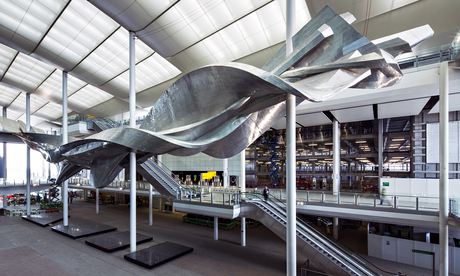Submitted by WA Contents
Richard Wilson: my giant Heathrow sculpture started in a vat of margarine
United Kingdom Architecture News - Apr 24, 2014 - 11:29 2954 views
by Oliver Wainwright
Richard Wilson made his prototype for Heathrow's new mega-sculpture Slipstream using a model Spitfire, a stick and some margarine. But is his swooping epic too great a departure from his mischievous, groundbreaking past?

'People can be nervous in airports. I didn't want to upset the passengers' … Richard Wilson’s Slipstream in Heathrow’s new Terminal 2. Photograph: David Levene for the Guardian
"I'm not a fan of airports," says Richard Wilson, getting into the lift at the end of a low-ceilinged corridor, after traipsing through Heathrow's warren of tunnels and travelators. "They can be spectacularly dreary places. There's usually nothing to do, except shuffle around looking at ties."
A moment later, the lift doors open, and our view is filled with an eruption of aluminium. A twisting, tumbling swoosh of metal leaps from one side of the atrium to the other.
"I thought this might make the journey a bit more exciting," says the 60-year-old artist, jumping back on the heels of his Doc Marten boots, a wild mop of hair swishing behind his balding head, giving him the look of a punk professor caught mid-Eureka moment. "I wanted to stop passengers in their tracks and make them go 'Oh shit!'"
In front of us, filling the entrance to Heathrow's new Terminal 2, stretches his latest work, Slipstream, a monumental feat that has been showered with superlatives before it has even opened. It is the longest piece of permanent art as well as the largest privately funded sculpture in Europe, stretching to 80 metres and weighing 77 tonnes. "It's my most expensive too," grins Wilson – costing £2.5m to build.
It may be only a thousandth of the total budget of the terminal project, and an even tinier fraction of the airport's ongoing £11bn transformation, but it is hoped that this billowing cloud of aluminium will leave the biggest impression on the 20 million visitors who will pass beneath it every year, once the terminal is open from June.
Plunging from the ceiling in a dramatic twist, performing an improbable back-flip at the arrivals level before swooping up past the escalator in a daring barrel roll towards departures, this sinuous metal serpent traces the path of an air show stunt plane, frozen in time and space. "It's like the trail behind every football in Roy of the Rovers comics," says Wilson, sweeping his hands through the air after an imaginary ball. "Everything leaves an invisible trail and I wanted to make that tangible, expressing the velocity and acceleration of flight."...Continue Reading
> via The Guardian
